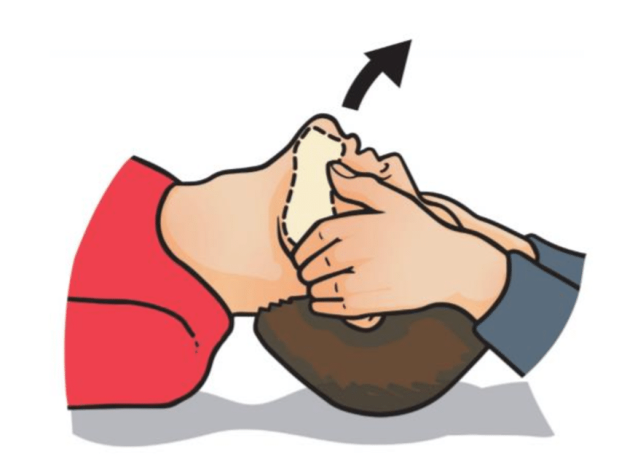6.2 BLS for Trauma Patients
Cardiac arrest in trauma patients presents unique challenges, including spinal injuries, severe bleeding, and airway compromise. Healthcare providers must adapt their approach to ensure effective resuscitation while minimizing further harm.
Key Challenges in Trauma Resuscitation
- Spinal Injuries: Cervical spine damage may require modified airway maneuvers.
- Hemorrhagic Shock: Uncontrolled bleeding can lead to hypovolemic arrest and requires immediate intervention.
- Chest Trauma: Conditions like pneumothorax and rib fractures can severely impair breathing and ventilation.
1. Airway Management with Spinal Precautions
- Always assume spinal injury in unresponsive trauma patients until proven otherwise.
- Use the
jaw thrust maneuver
instead of head tilt–chin lift.×jaw thrust maneuver
 © FAW Training Solutions – All rights reserved
© FAW Training Solutions – All rights reserved - Stabilize the cervical spine during airway management.
2. Chest Compressions in Trauma
- Deliver compressions at 100–120 per minute with a depth of at least 2 inches (5 cm).
- Continue compressions even if effectiveness may be reduced due to injuries like rib fractures or flail chest.
- In cases of penetrating chest trauma, surgical interventions (e.g., thoracotomy) may be required quickly.
3. Managing Hemorrhagic Shock
- Hemorrhage control is a top priority in trauma-related cardiac arrest.
- Use the following techniques for severe bleeding:
- Direct pressure to control external bleeding.
- Tourniquets for life-threatening limb hemorrhage.
- Wound packing with hemostatic dressings for junctional injuries (e.g., groin, axilla).
- Initiate massive transfusion protocols in a hospital setting when available.
4. Recognizing and Managing Chest Trauma
- Pneumothorax (Collapsed Lung):
- Absent breath sounds on one side
- Tracheal deviation (late sign)
- Distended neck veins (in tension pneumothorax)
- Flail Chest: Multiple rib fractures causing paradoxical chest wall movement.
Treatment: Oxygen support, assisted ventilation, and potential early intubation.
Key Takeaways
- Use the jaw thrust maneuver when spinal injury is suspected.
- Continue chest compressions even when trauma reduces their effectiveness.
- Control bleeding with pressure, tourniquets, or wound packing as appropriate.
- Watch for chest injuries that impair ventilation and support as needed until advanced care arrives.
Adapting BLS for trauma patients requires rapid assessment and modification of standard techniques to maximize survival while preventing further injury.
Next, we’ll discuss how to recognize and manage cardiac arrest in opioid overdose, a growing cause of emergency resuscitations.